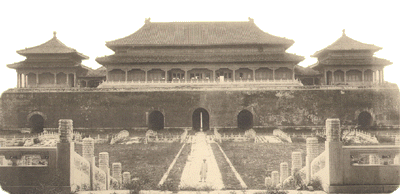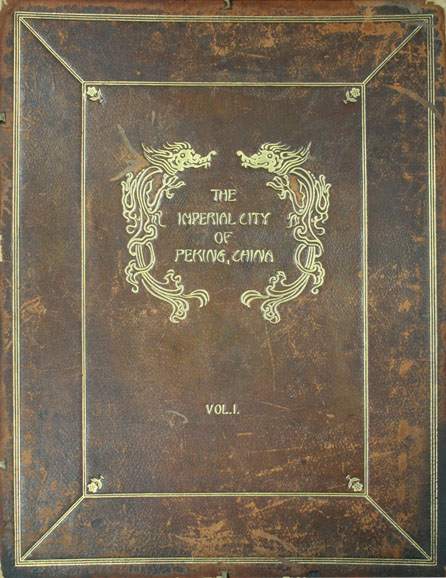|
Ogawa, K. (Kazumasa) (Photographs/Collotype Plates)
Ito, Chiuta (Booklet - Author of Text, Japanese)
Tomiogi, T. (Booklet - Translator for English Text)
Aoyage, A. (Booklet - Translator for Chinese Text):
The Imperial City of Peking, China (Title on Folio Housing), Photographs of Palace Buildings of Peking Compiled by The Imperial Museum of Tokyo, Collotyped from the Negatives Taken by K. Ogawa , F.R.P.S. With Explanatory Notes in Japanese by C. Ito, Kogakuhakushu, English by T. Tomiogi, Bungakushi, Chinese by A. Aoyage, Limited Edition of 500 Copies (each copy numbered) (Title on Booklet), Tokyo, Kazumasa Ogawa, text printed by the Tokyo Tsukiji Type Foundry, 1906, two volumes, folio (18 1/2 x 14 5/16 in - 46.5 x 36.4 cm). Volume 1 contains descriptive booklet (text in English, Japanese & Chinese) and 65 collotype plate, five of which fold out. Volume 2 contains plates 66-172. All plates are loose.
The Japanese title for this work is generally cited as Shinkoku Pekin kojo.
The conclusion of the Boxer Uprising in 1901 lead to Japan receiving international recognition as a major political power and becoming one of the allied powers occupying China. The Imperial University of Tokyo established a Commission headed by Professor Chiuta Ito of the College of Engineering to investigate the "...arrangement, construction and decoration of the Palace Building in the 'Forbidden City' and other Palace Grounds." Kazumasa Ogawa was the photographer for this Commission. The work of the Commission became the property of the Imperial Museum of Tokyo. The Museum authorized K. Ogawa to publish "above 170" of the photographs, and the accompanying notes, which were considered to represent "... all the important views and edifices within the city..." The grandeur of these important cultural properties is sometimes tarnished by their state of disrepair and lack of upkeep.
Booklet (Notes).
- Composition. The booklet is composed of a total of 41 leaves. Several of the leaves are unnumbered and a few are printed on one side only. The English text section reads European style from front to back. It is composed of 12 leaves and has 18 pages that are numbered. The Japanese and Chinese text sections read Japanese style from back to front. These sections contain 29 leaves. The Japanese section spans 17 leaves and has 17 numbered pages. The Chinese section covers 12 leaves and has 19 numbered pages. This booklet is sometimes described as having 54 pages. This is arrived at by adding the numbered pages (18 numbered pages - English, 17 numbered pages - Japanese & 19 numbered pages - Chinese. While most leaves are printed on both sides, some have printing on only one side. Further, some printed pages are not numbered. I believe the better way to characterize the booklet is by the total number of leaves which is 41.
- Contents of English Section.
Title Page (1 page, printed one side only)
Preface (1 page)
Publisher's Note (1 page)
Table of Contents (Summarized/Captions Only - 2 pages)
General Description (3 pages, numbered pages 1-3)
I. The Imperial City of Peking.
II. The Principal Edifices in the Forbidden City.
III. The Hsi-Yuan.
IV. The Wan-Shou Shan.
V. The 'Temple of Heaven.'
VI. The 'Temple of Agriculture.'
VII. The 'Temple of the Sun.'
VIII. The 'Yuan-he Palace.'
IX. The 'Yellow Temples.'
X. The Wen Miao.
Explanatory Notes (15 pages, numbered pages 4-18, a sentence
or two discussion of each of the 172 plates)
- Colophon. The colophon for the book is in Japanese and found at the end of the English language section.
- Size & Characteristics of Leaves. The booklet is printed on leaves exactly the same size as the single panel plates (18 1/2 x 14 5/16 in - 46.5 x 36.4 cm). The paper is thick stock which appears to be identical to that used for the plates. The outside corners of the pages are rounded just as with the plates.
- Binding. The booklet is covered in stiff unillustrated thin stock paper which wraps around the spine. While the exact binding technique is not clear, it appears to be bound by string ties as their impression is visible on the outside of the wraps adjacent to the spine. To see the covers, click here.
- Text Printer. The text portion of the booklet was printed by the Tokyo Tsukiji Type Foundry.
Plates.
- Type of Printing. The plates are high quality collotype printed by K. Ogawa and from photographs that he took. Below is a close-up of a small (two square centimeter) area of collotype printing from plate 2.
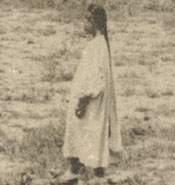
- Size & Characteristics of the Plates. The plates are on very thick paper stock with the corners rounded. The normal plate size is 18 1/2 x 14 5/16 in (46.5 x 36.4 cm). The printed images cover from 50%-70% of the plate.
- Fold-out Plates. In Volume 1 there are 5 fold-out plates. These plates are made up of two or three panels. All panels are 14 5/16 in (36.4 cm) in height but the panel widths vary. The largest of these fold-out plates is 3 3/4 ft wide when folded out. These panels are attached at the edges by a very thin translucent rice paper type binding strip.
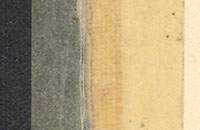
- Lettering. All lettering on the plates is typeset in red. In the upper left corner is the plate number. In the upper right corner is the plate number in Japanese. Immediately outside the collotype printed area in the lower right corner is "COPYRIGHT, 1906, by the Imperial Museum of Tokyo." At the bottom left side of the collotype image there is an inscription in Japanese reading "Imperial Museum, Tokyo." Centered below the collotype image is the descriptive title of the plate in English. In Japanese/Chinese to the right and left (usually dropped down below the English text) is the descriptive title in Japanese/Chinese. Both of these inscriptions are almost always identical but I assume one is Japanese and the other is Chinese.
Example of Entire Single Panel Plate Showing Lettering
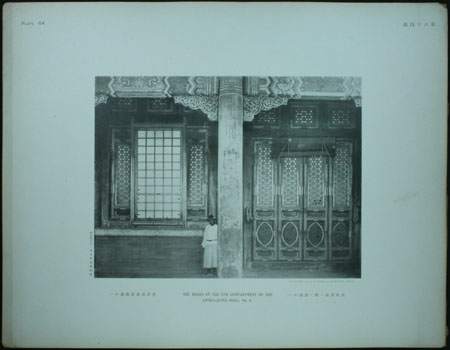
Folio Case. Volume 1 is housed in a two piece folio (top and bottom) case. Both sections are blindstamped leather. The top section has gilt letter and lining. The two sections are secured by four leather type ties. The fore-edge does not have a leather tie. To see the two sections, click here.
Facsimile Reprint of the Chinese text portion of the booklet and 170 of the 172 plates. Qing dai Beijing Huang Cheng Xie Zhen Tie (Photographs of Palace Buildings of Beijing), Beijing, Xue Yuan Chu Ban She, 2000, 19 pages of Chinese text, 170 plates, silk folding case, plates loose. Plates 169 and 170 (The Gate of a Privea House, No 1 & 2) were not reproduced "due to their content." These two plates contain views of the a Japanese garrison located at the Privea House. The facsimile is smaller than the original measuring 42 x 29 cm versus the original which measures 46.5 x 36.5 cm.
For information on Kazumasa Ogawa, click here.
Booklet
Title Page (English Section)
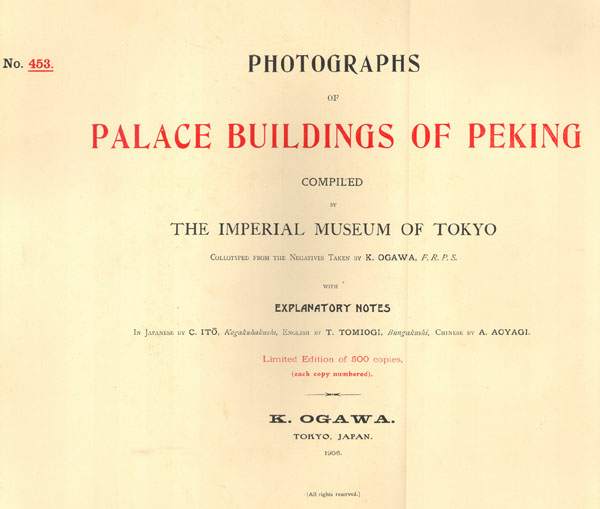 Preface (English)
Preface (English)
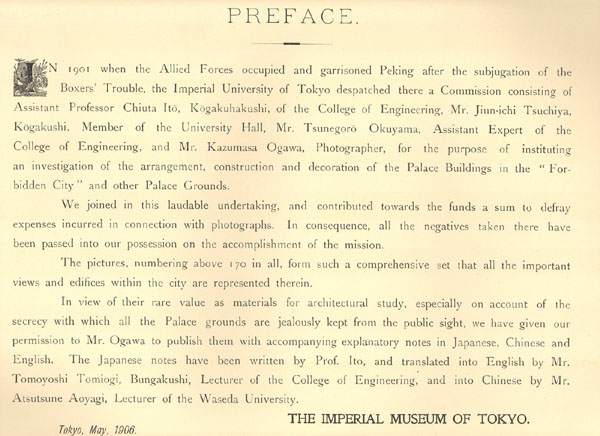 Publisher's Note (English)
Publisher's Note (English)
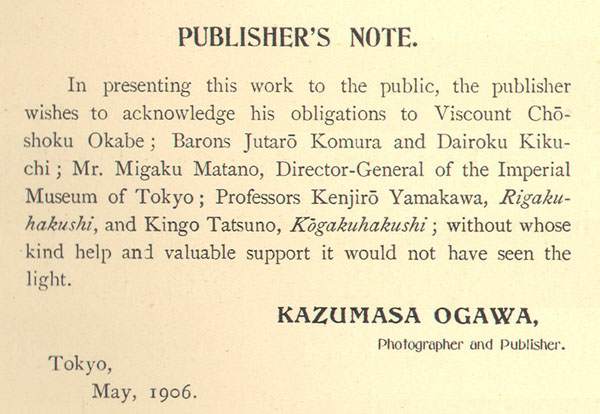 Table of Contents (English)
Table of Contents (English)
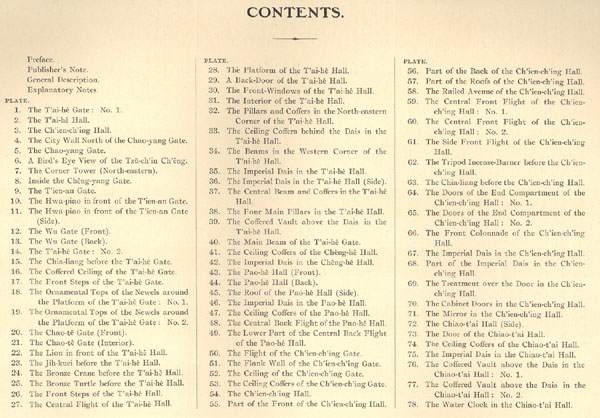
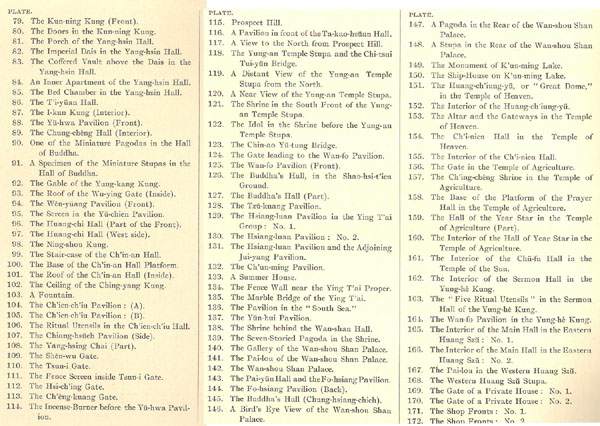 Colophon
Colophon
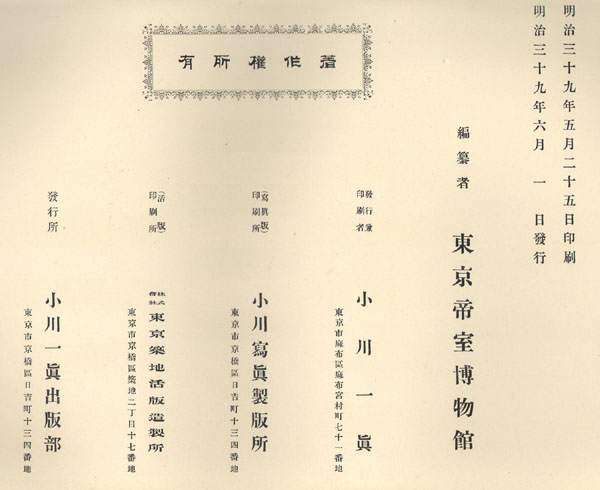 Title Page (Japanese Section)
Title Page (Japanese Section)
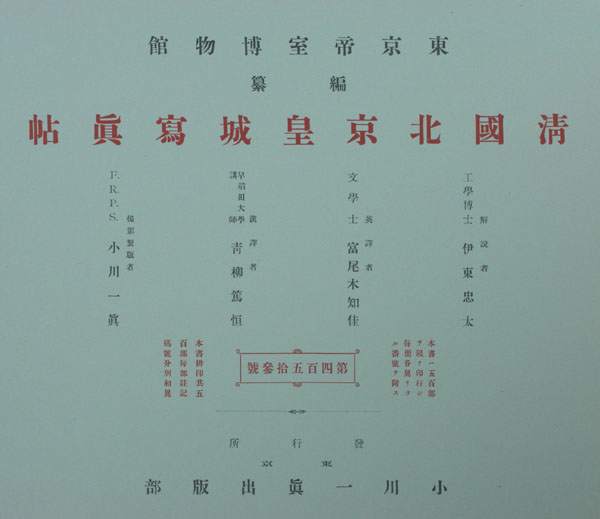 Calligraphy Page (China Section?)
Calligraphy Page (China Section?)
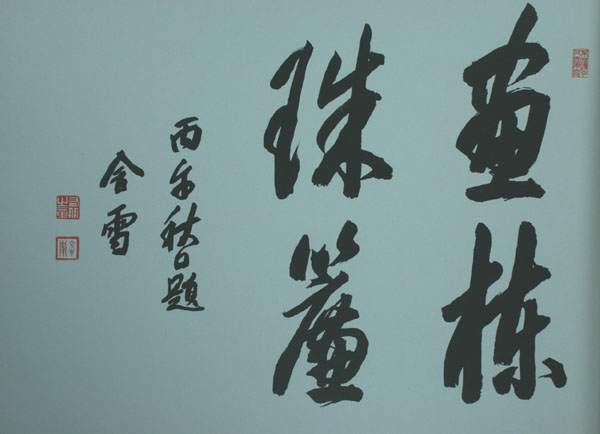
Plates 1-65 (Vol 1 only)
1. The T'ai-he Gate: No. 1
 (3 panels, 40 13/16 x 14 5/16 in - 103.6 x 36.4 cm)
2. The T'ai-he Hall
(3 panels, 40 13/16 x 14 5/16 in - 103.6 x 36.4 cm)
2. The T'ai-he Hall
 (3 panels, 45 1/4 x 14 5/16 in - 115 x 36.4 cm)
3. The Ch'ien-ch'ing Hall
(3 panels, 45 1/4 x 14 5/16 in - 115 x 36.4 cm)
3. The Ch'ien-ch'ing Hall
 (3 panels, 45 x 14 5/16 in - 114.5 x 36.4 cm)
4. The City Wall North of Chao-yang Gate
(3 panels, 45 x 14 5/16 in - 114.5 x 36.4 cm)
4. The City Wall North of Chao-yang Gate
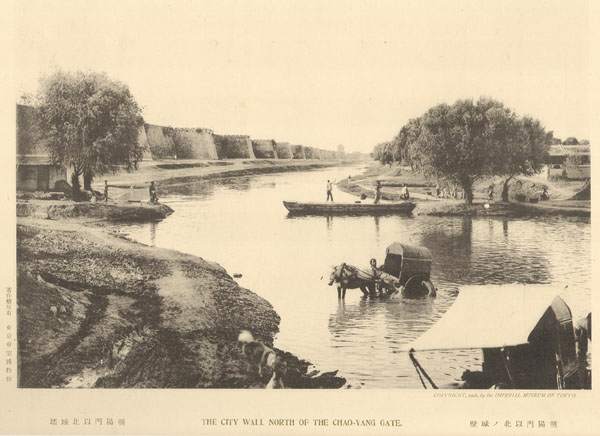 5. The Chao-yang Gate
5. The Chao-yang Gate
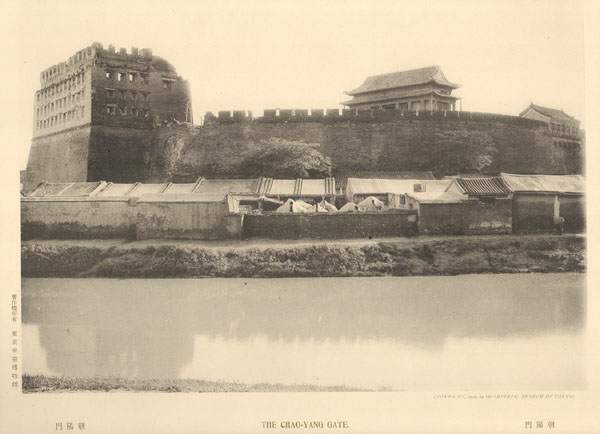 6. A Bird's Eye View of Tzu-ch'in Ch'eng
6. A Bird's Eye View of Tzu-ch'in Ch'eng
 (3 panels, 43 1/4 x 14 5/16 in - 110 x 36.4 cm)
7. The Corner Tower (North-eastern)
(3 panels, 43 1/4 x 14 5/16 in - 110 x 36.4 cm)
7. The Corner Tower (North-eastern)
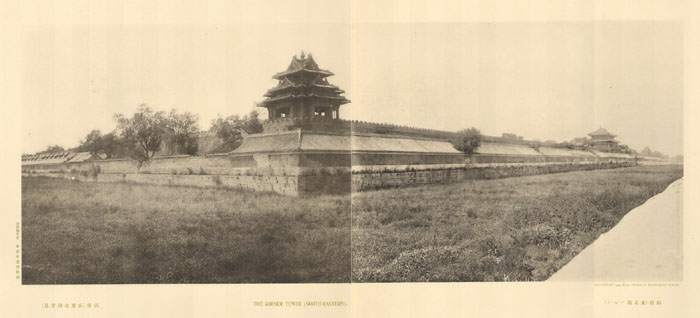 (2 panels, 30 1/8 x 14 5/16 in - 77 x 36.4 cm)
8. Inside the Cheng-yang Gate
(2 panels, 30 1/8 x 14 5/16 in - 77 x 36.4 cm)
8. Inside the Cheng-yang Gate
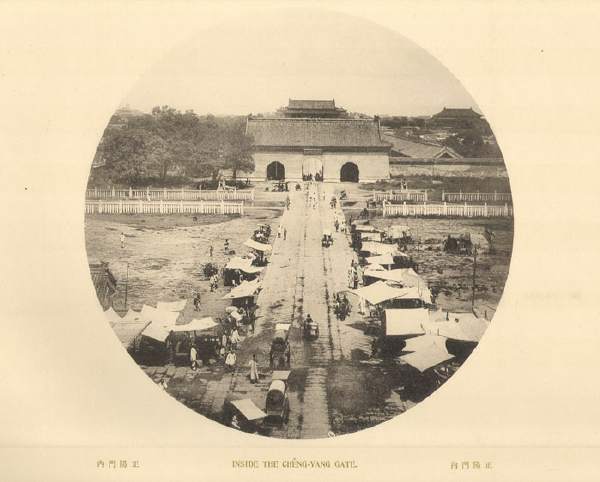 9. The T'ien-an Gate
9. The T'ien-an Gate
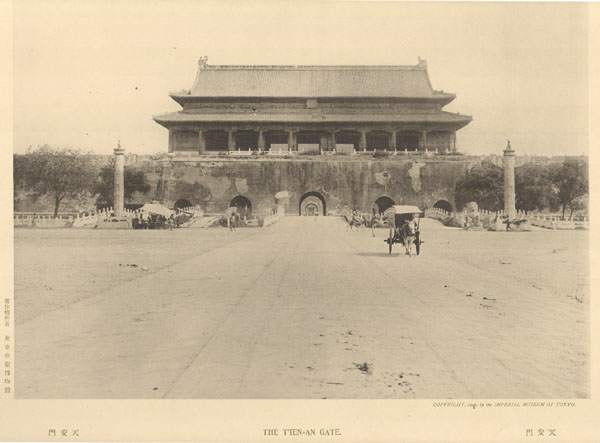 10. The Hwa-piao in front of the T'ien-an Gate
10. The Hwa-piao in front of the T'ien-an Gate
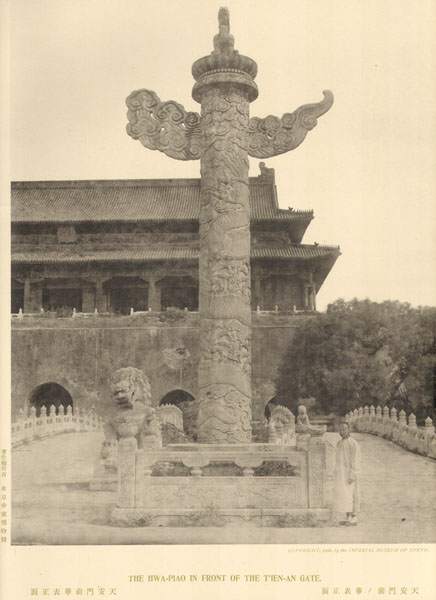 11. The Hwa-piao in front of the T'ien-an Gate (Side)
11. The Hwa-piao in front of the T'ien-an Gate (Side)
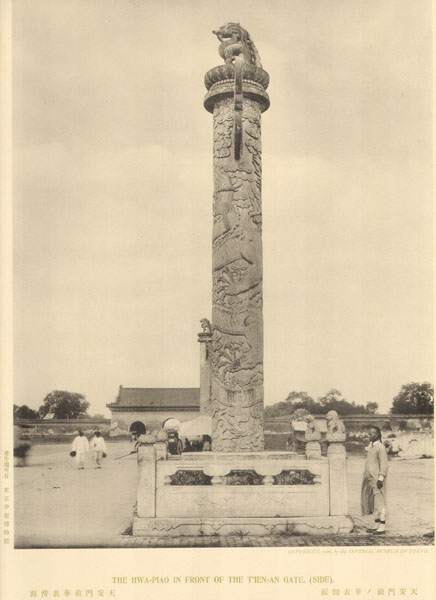 12. The Wu Gate (Front)
12. The Wu Gate (Front)
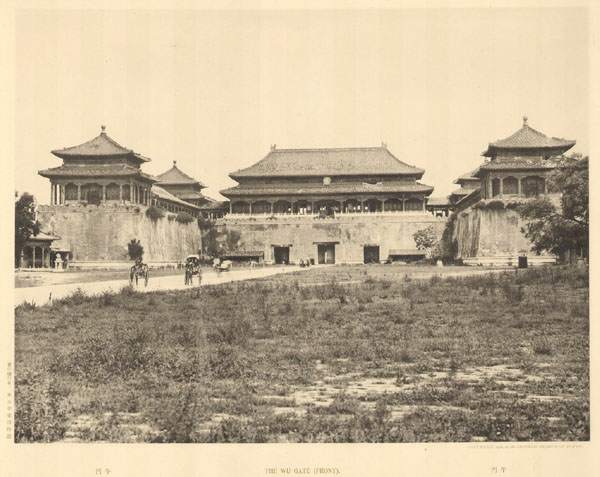 13. The Wu Gate (Back)
13. The Wu Gate (Back)
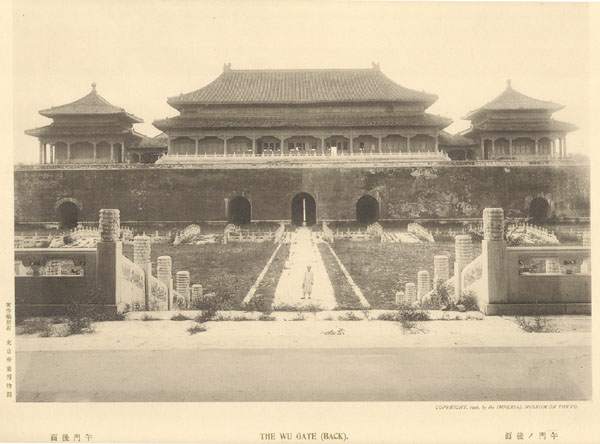 14. The T'ai-he Gate; No. 2
14. The T'ai-he Gate; No. 2
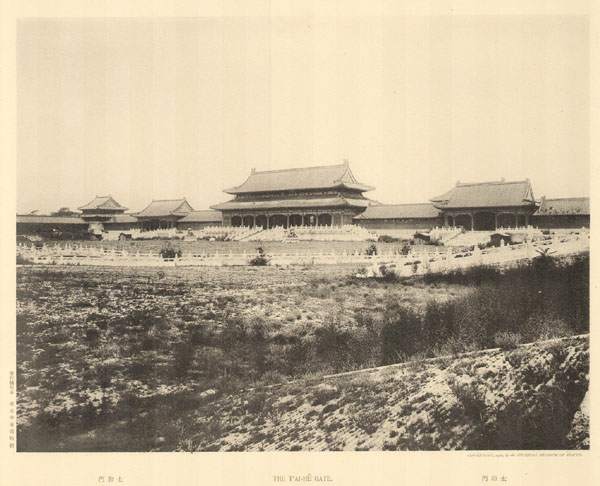 15. The Chia-liang before the T'ai-he Gate
15. The Chia-liang before the T'ai-he Gate
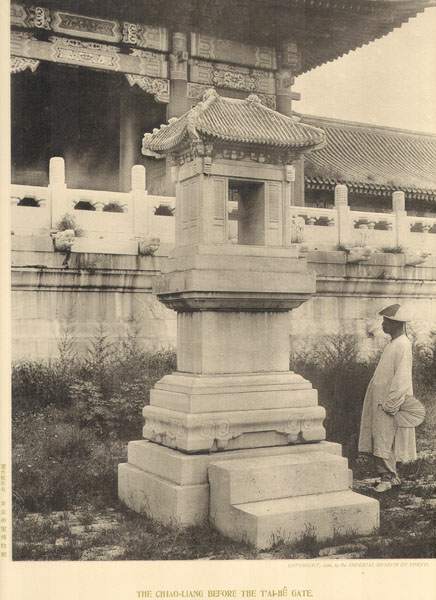 16. The Coffered Ceiling of the T'ai-he Gate
16. The Coffered Ceiling of the T'ai-he Gate
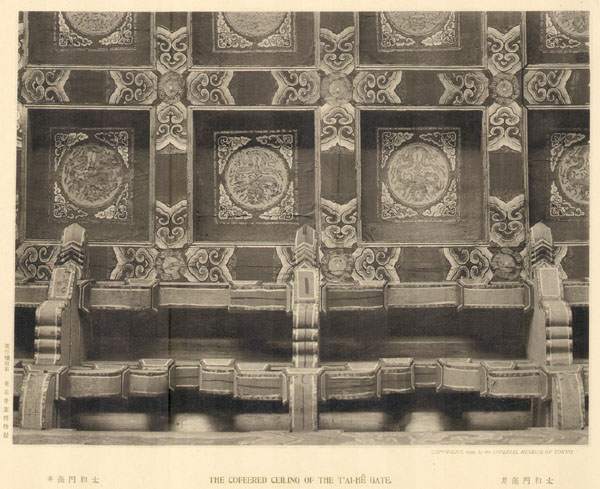 17. The Front Steps of the T'ai-he Gate
17. The Front Steps of the T'ai-he Gate
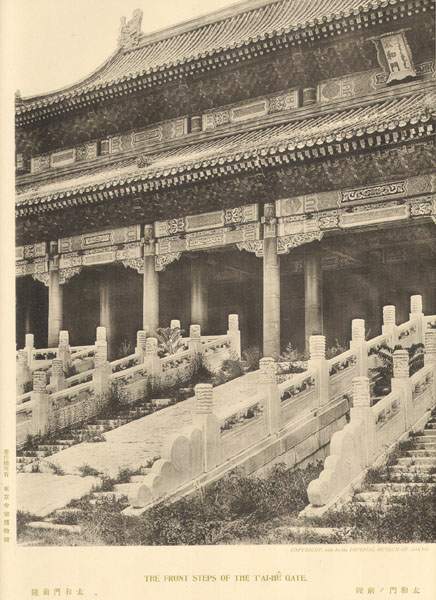 18. The Ornamental Tops of the Newels around the
Platform of the T'ai-he Gate: No. 1
18. The Ornamental Tops of the Newels around the
Platform of the T'ai-he Gate: No. 1
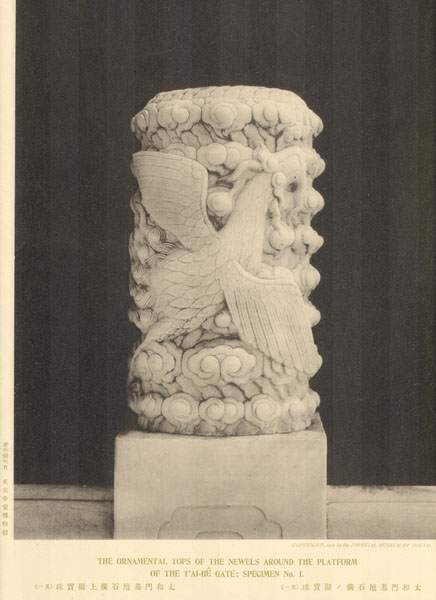 19. The Ornamental Tops of the Newels around the
Platform of the T'ai-he Gate: No. 2
19. The Ornamental Tops of the Newels around the
Platform of the T'ai-he Gate: No. 2
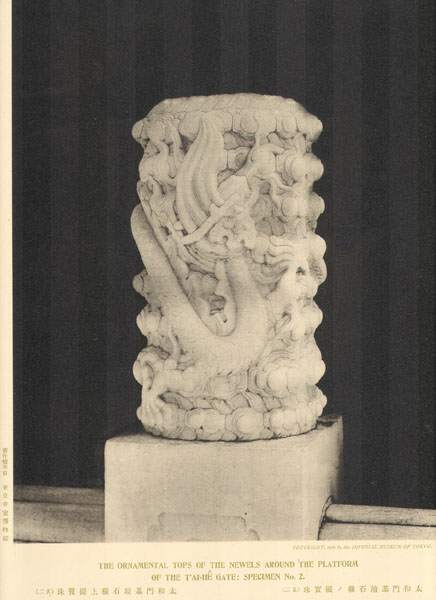 20. The Chao-te Gate (Front)
20. The Chao-te Gate (Front)
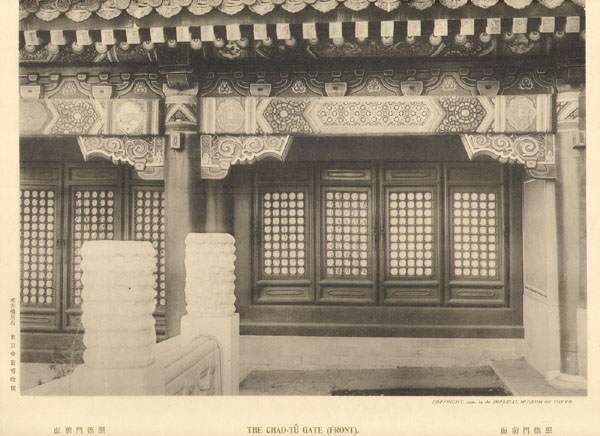 21. The Chao-te Gate (Interior)
21. The Chao-te Gate (Interior)
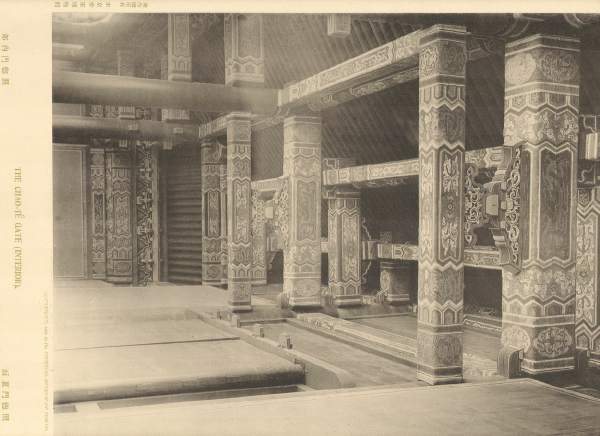 22. The Lion in front of the T'ai-he Hall
22. The Lion in front of the T'ai-he Hall
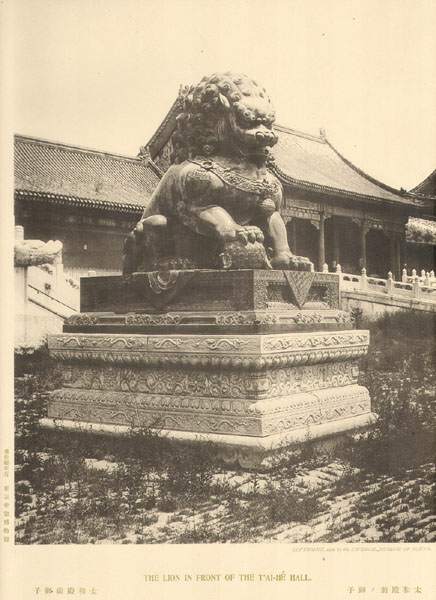 23. The Jih-kuei before the T'ai-he Hall
23. The Jih-kuei before the T'ai-he Hall
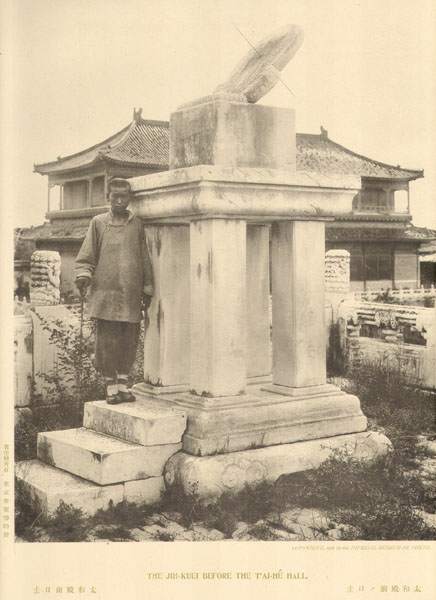 24. The Bronze Crane before T'ai-he Hall
24. The Bronze Crane before T'ai-he Hall
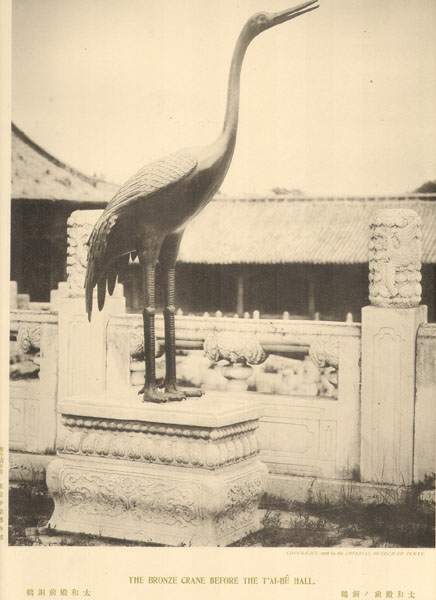 25. The Bronze Turtle before T'ai-he Hall
25. The Bronze Turtle before T'ai-he Hall
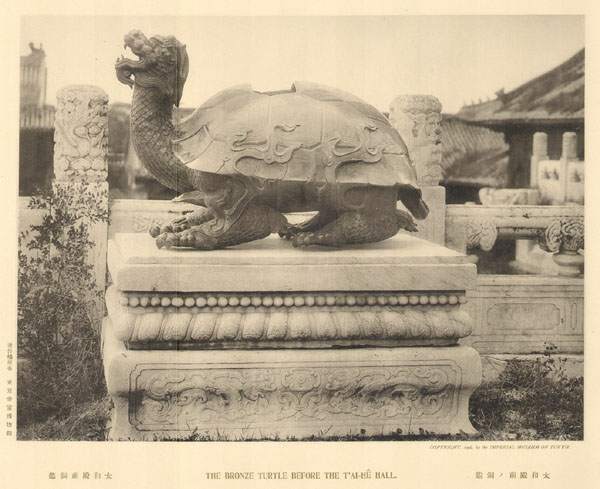 26. The Front Steps of the T'ai-he Hall
26. The Front Steps of the T'ai-he Hall
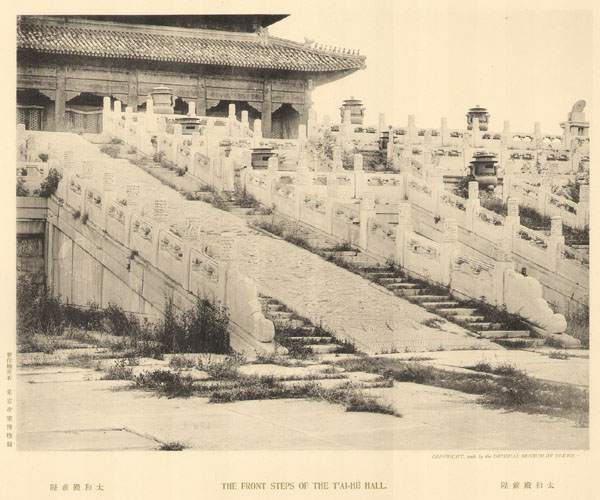 27. The Central Flight of the T'ai-he Hall
27. The Central Flight of the T'ai-he Hall
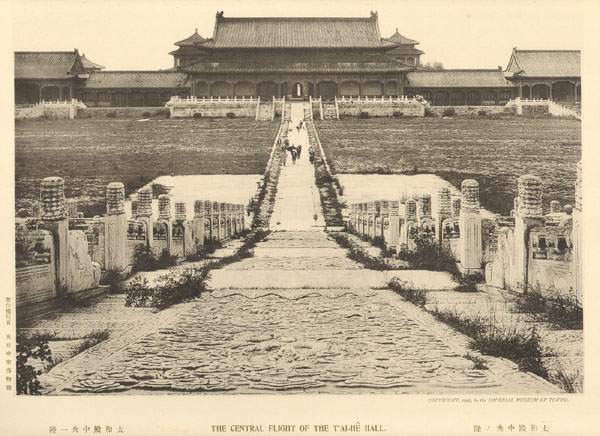 28. The Platform of the T'ai-he Hall
28. The Platform of the T'ai-he Hall
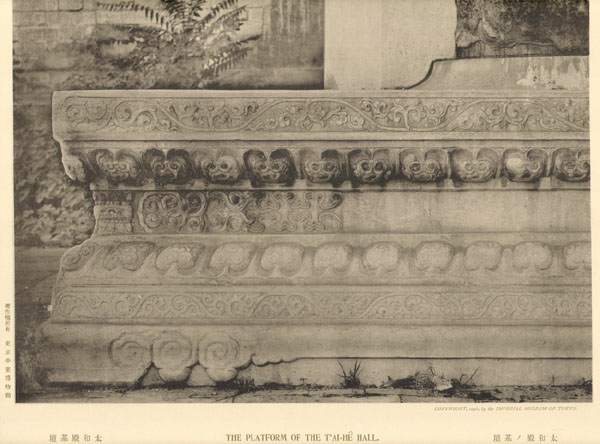 29. A Back-Door of the T'ai-he Hall
29. A Back-Door of the T'ai-he Hall
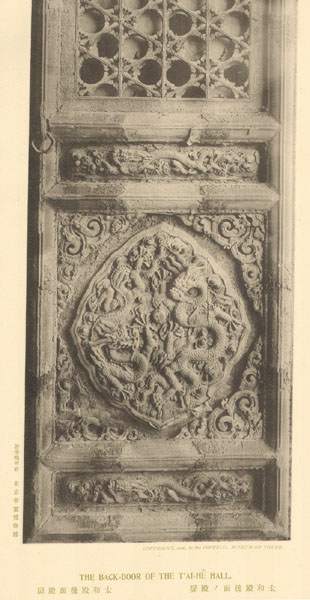 30. The Front-Windows of the T'ai-he Hall
30. The Front-Windows of the T'ai-he Hall
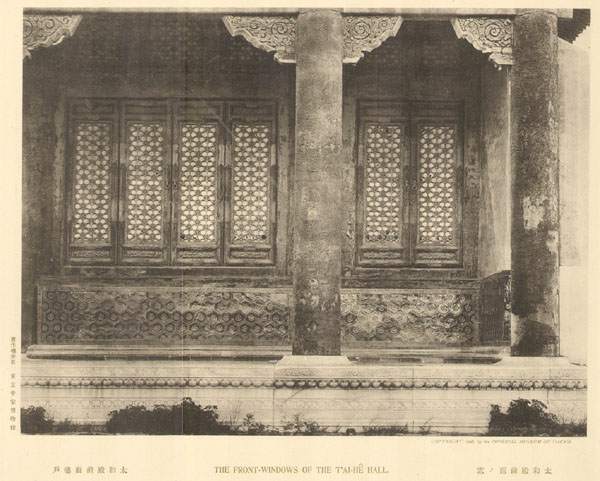 31. The Interior of the T'ai-he Hall
31. The Interior of the T'ai-he Hall
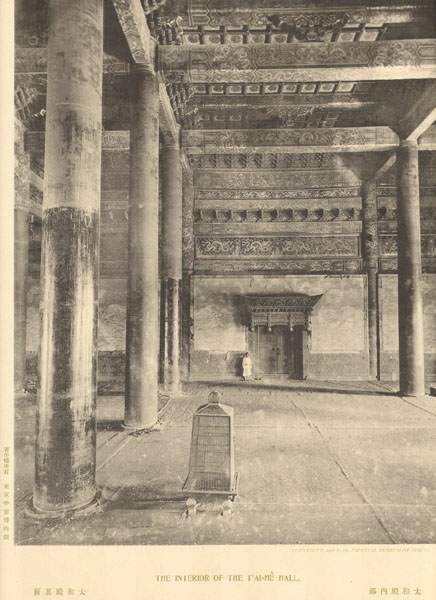 32. The Pillars and Coffers in the North-eastern
Corner of the T'ai-he Hall
32. The Pillars and Coffers in the North-eastern
Corner of the T'ai-he Hall
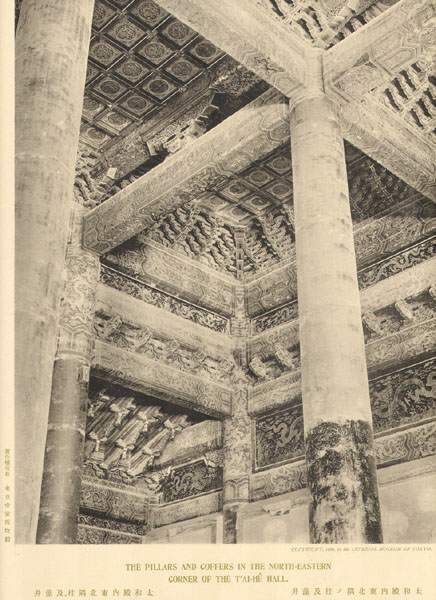 33. The Ceiling Coffers behind the Dias in
the T'ai-he Hall
33. The Ceiling Coffers behind the Dias in
the T'ai-he Hall
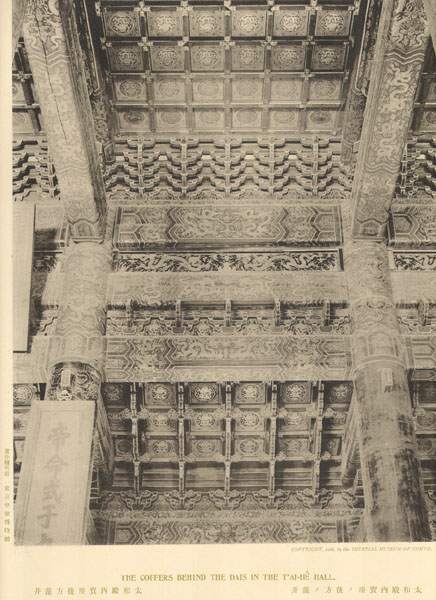 34. The Beams of the Western Corner of the T'ai-he Hall
34. The Beams of the Western Corner of the T'ai-he Hall
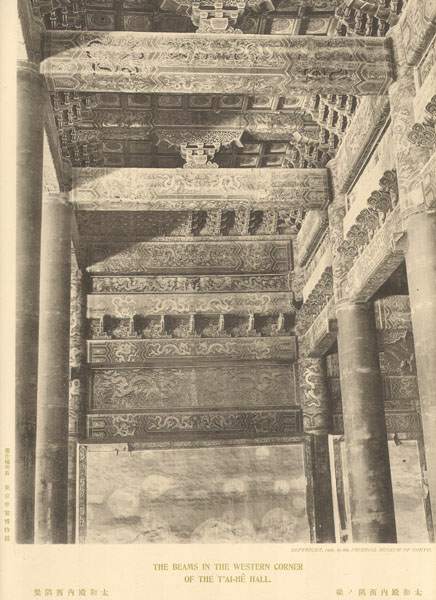 35. The Imperial Dais in the T'ai-he Hall
35. The Imperial Dais in the T'ai-he Hall
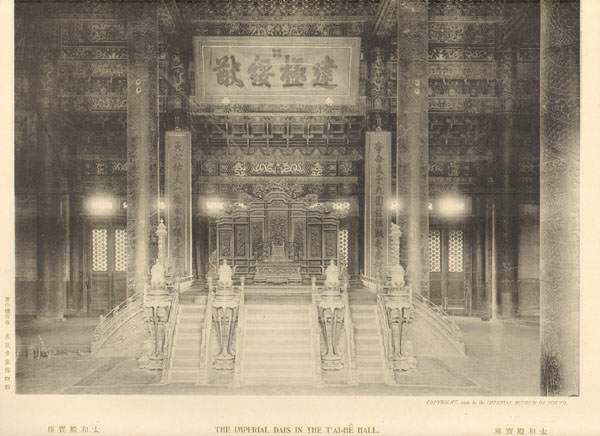 36. The Imperial Dais in the T'ai-he Hall
36. The Imperial Dais in the T'ai-he Hall
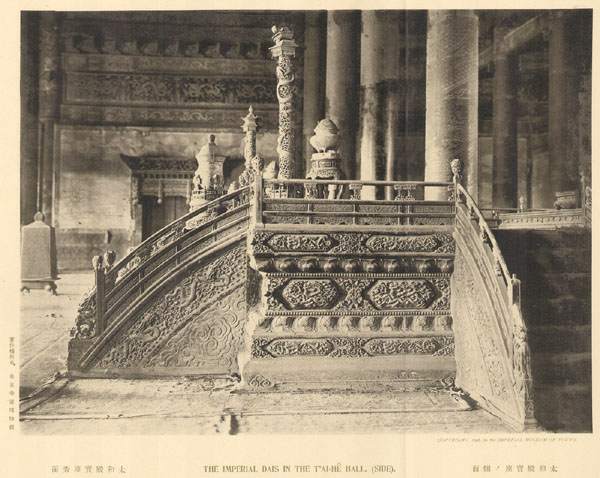 37. The Central Beam and Coffers in the T'ai-he Hall
37. The Central Beam and Coffers in the T'ai-he Hall
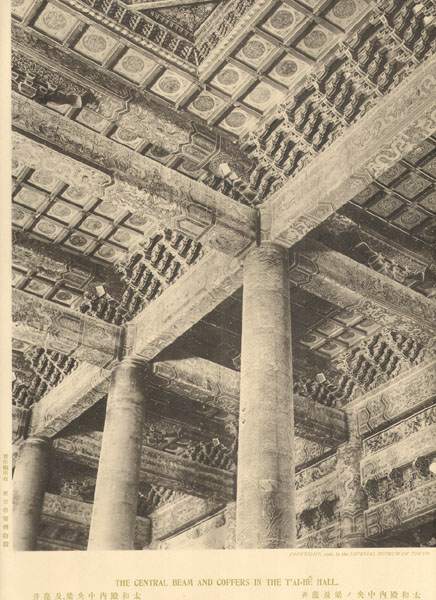 38. The Four Main Pillars in the T'ai-he Hall
38. The Four Main Pillars in the T'ai-he Hall
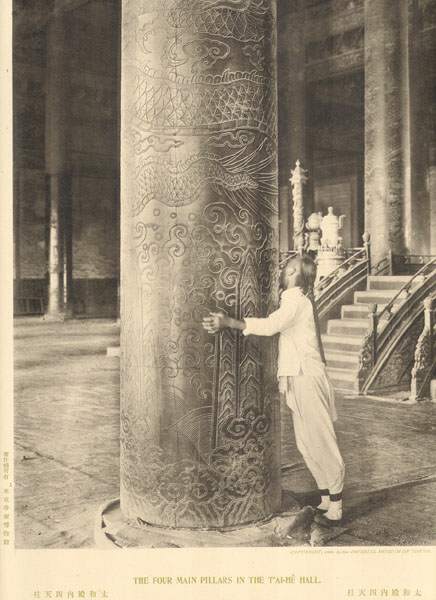 39. The Coffered Vault above the Dais in the T'ai-he Hall
39. The Coffered Vault above the Dais in the T'ai-he Hall
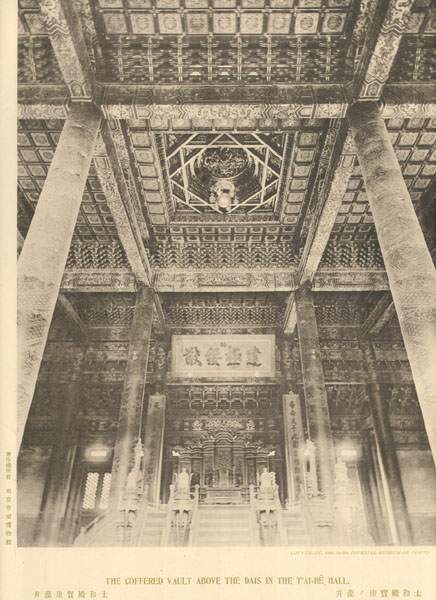 40. The Main Beam of the T'ai-he Hall
40. The Main Beam of the T'ai-he Hall
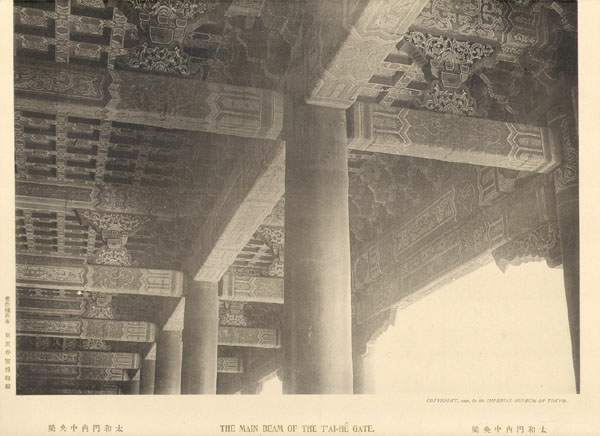 41. The Ceiling Coffers of the Cheng-he Hall
41. The Ceiling Coffers of the Cheng-he Hall
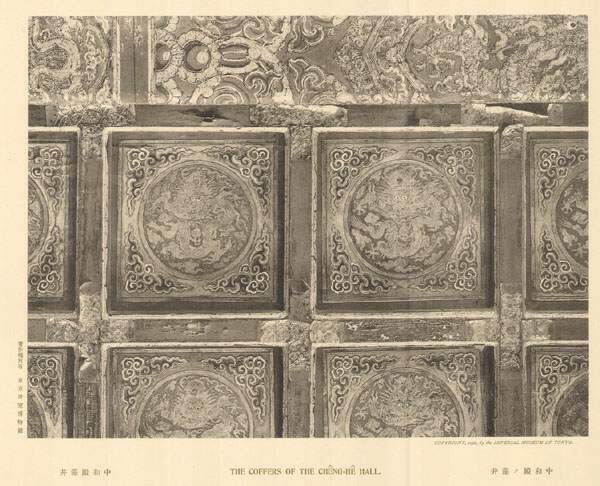 42. The Imperial Dais in the Cheng-he Hall
42. The Imperial Dais in the Cheng-he Hall
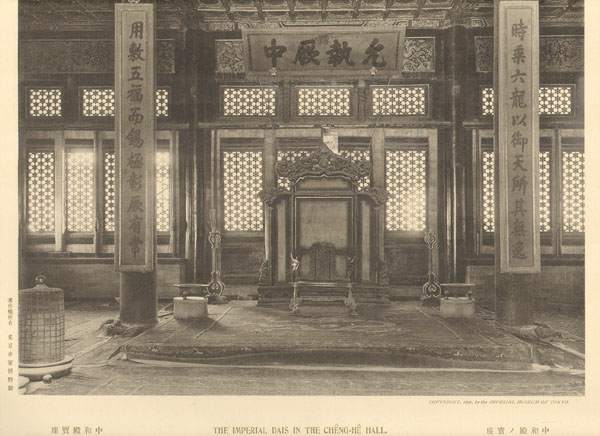 43. The Pao-he Hall (Front)
43. The Pao-he Hall (Front)
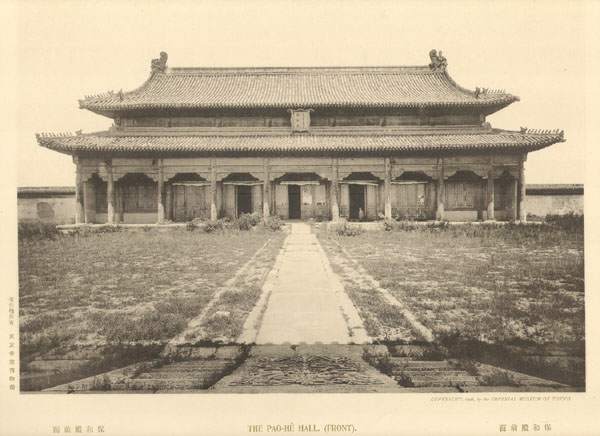 44. The Pao-he Hall (Back)
44. The Pao-he Hall (Back)
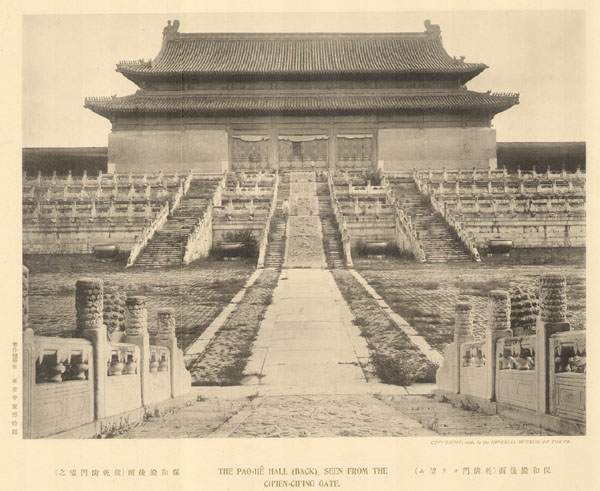 45. The Roof of the Pao-he Hall (Side)
45. The Roof of the Pao-he Hall (Side)
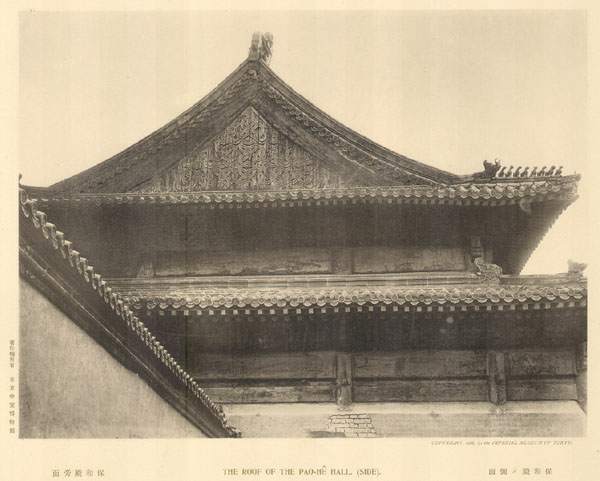 46. The Imperial Dais in the Pao-he Hall (Side)
46. The Imperial Dais in the Pao-he Hall (Side)
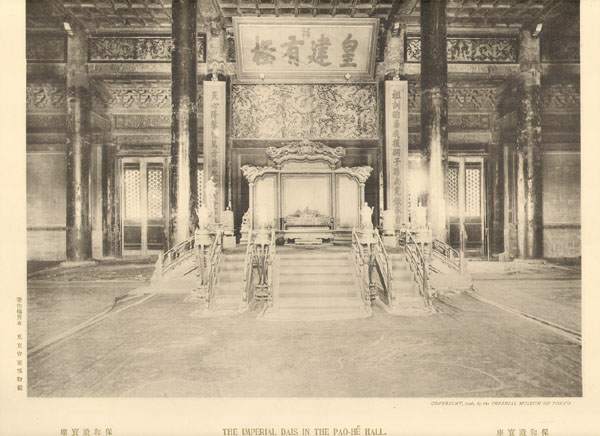 47. The Ceiling Coffers of the Pao-he Hall
47. The Ceiling Coffers of the Pao-he Hall
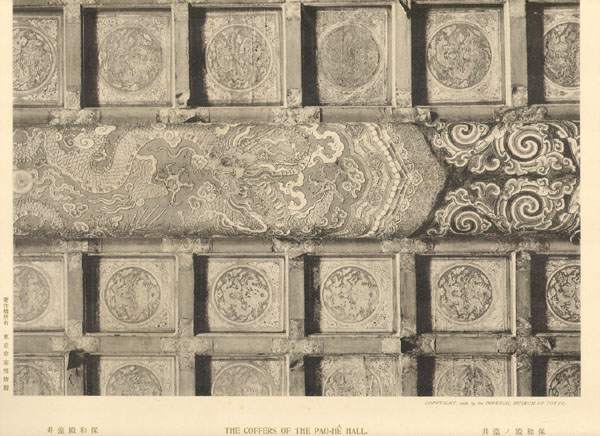 48. The Central Back Flight of the Pao-he Hall
48. The Central Back Flight of the Pao-he Hall
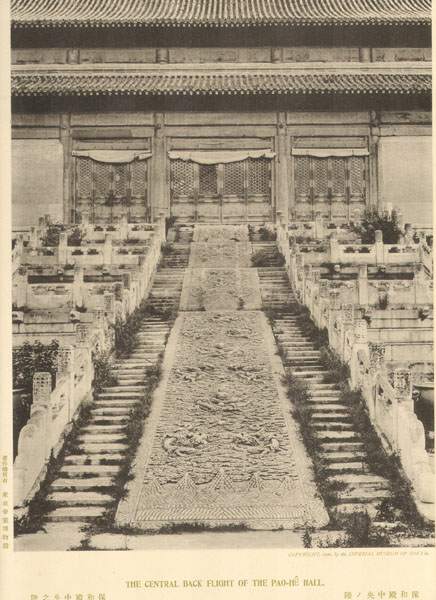 49. The Lower Part of the Central Back Flight of
the Pao-he Hall
49. The Lower Part of the Central Back Flight of
the Pao-he Hall
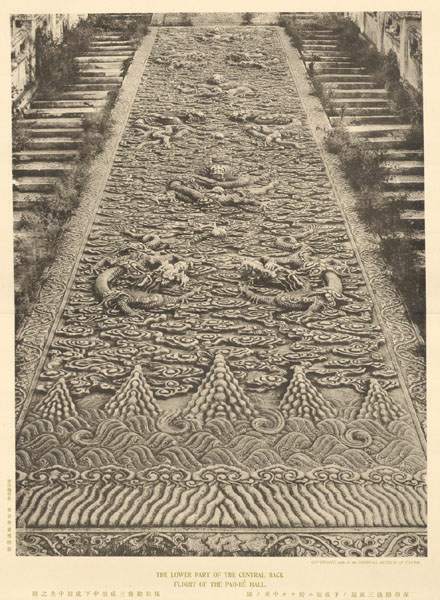 50. The Flight of the Ch'ien-ch'ing Gate
50. The Flight of the Ch'ien-ch'ing Gate
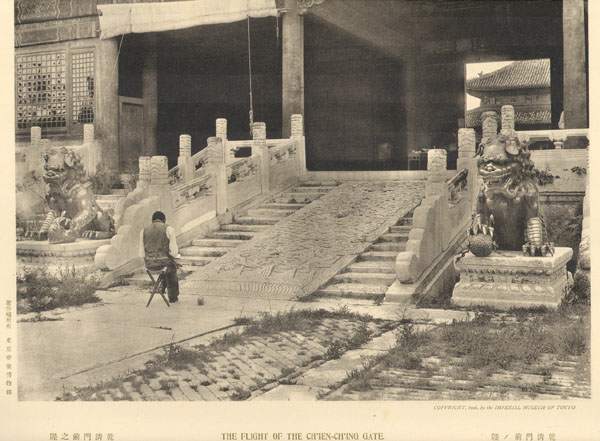 51. The Flank Wall of the Ch'ien-ch'ing Gate
51. The Flank Wall of the Ch'ien-ch'ing Gate
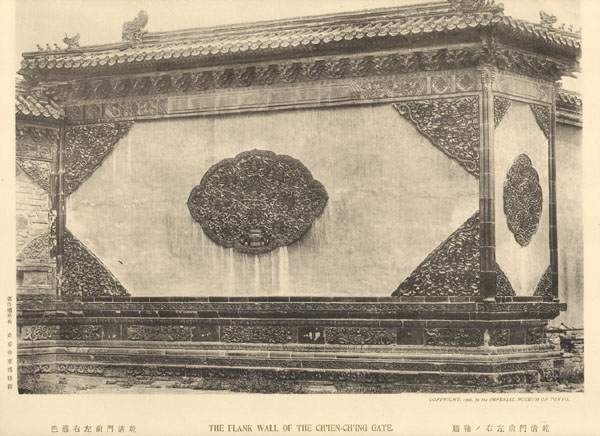 52. The Ceiling of the Ch'ien-ch'ing Gate
52. The Ceiling of the Ch'ien-ch'ing Gate
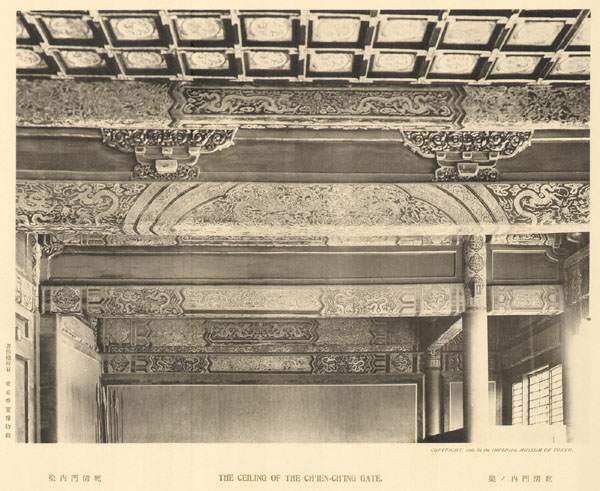 53. The Ceiling Coffers of the Ch'ien-ch'ing Gate
53. The Ceiling Coffers of the Ch'ien-ch'ing Gate
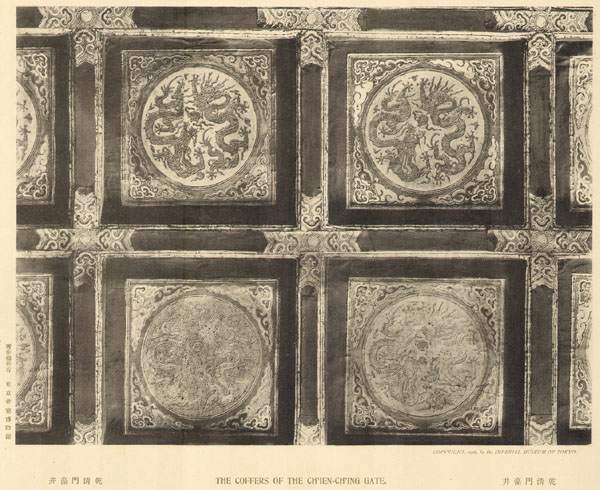 54. The Ch'ien-ch'ing Hall
54. The Ch'ien-ch'ing Hall
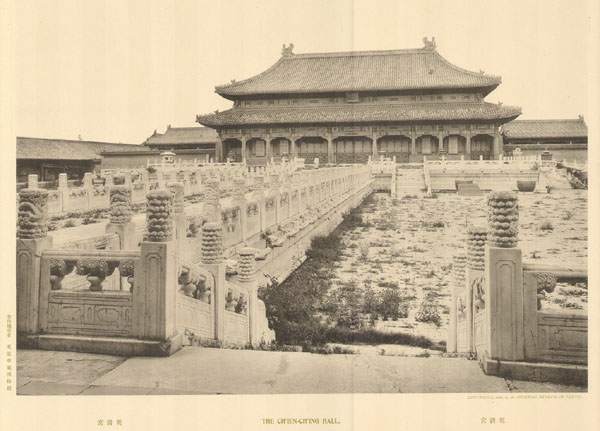 55. Part of the Front of the Ch'ien-ch'ing Hall
55. Part of the Front of the Ch'ien-ch'ing Hall
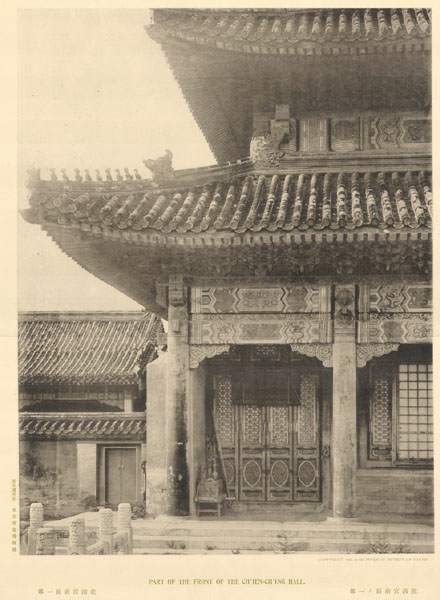 56. Part of the Back of the Ch'ien-ch'ing Hall
56. Part of the Back of the Ch'ien-ch'ing Hall
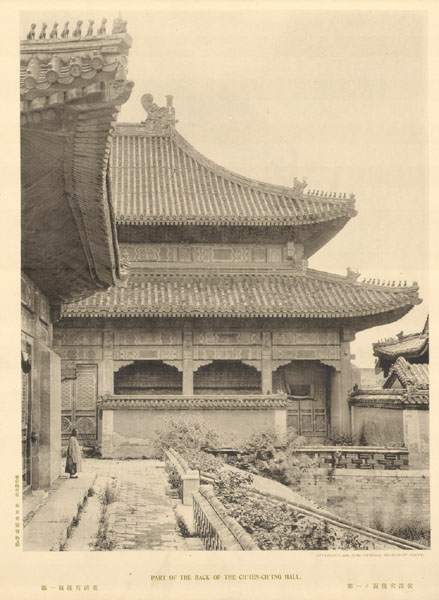 57, Part of the Roofs of the Ch'ien-ch'ing Hall
57, Part of the Roofs of the Ch'ien-ch'ing Hall
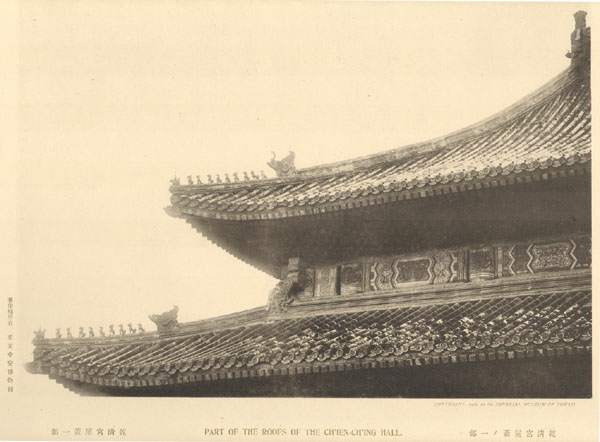 58. The Railed Avenue of the Ch'ien-ch'ing Hal
58. The Railed Avenue of the Ch'ien-ch'ing Hal
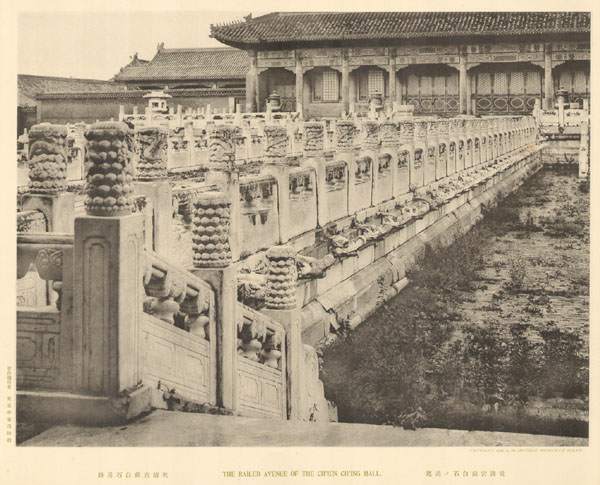 59. The Central Front Flight of the
Ch'ien-ch'ing Hall: No. 1
59. The Central Front Flight of the
Ch'ien-ch'ing Hall: No. 1
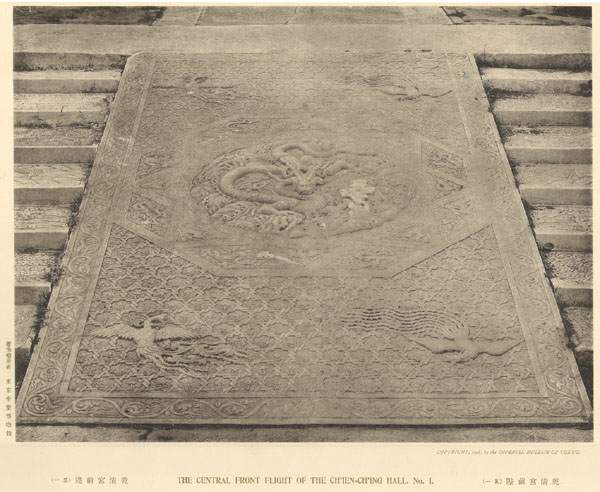 60. The Central Front Flight of the
Ch'ien-ch'ing Hall: No. 2
60. The Central Front Flight of the
Ch'ien-ch'ing Hall: No. 2
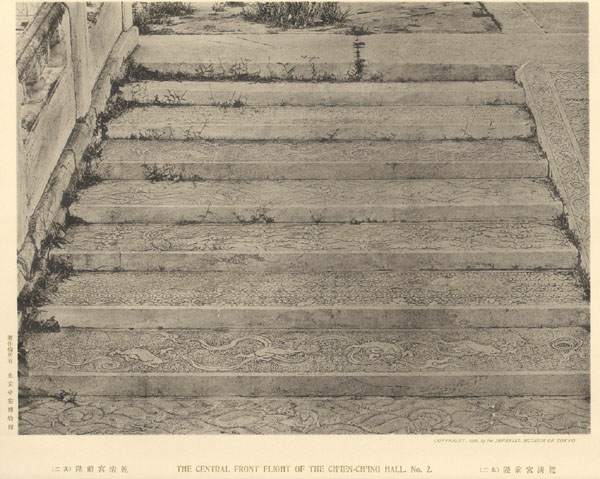 61. The Side Front Flight of the Ch'ien-ch'ing Hall
61. The Side Front Flight of the Ch'ien-ch'ing Hall
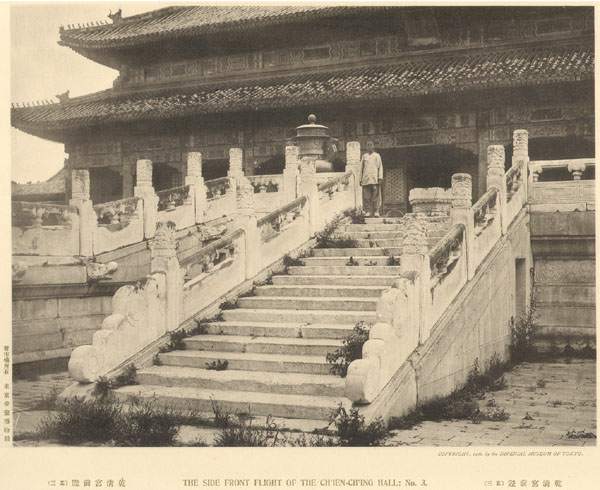 62. The Tripod Incense-Burner before the Ch'ien-ch'ing Hall
62. The Tripod Incense-Burner before the Ch'ien-ch'ing Hall
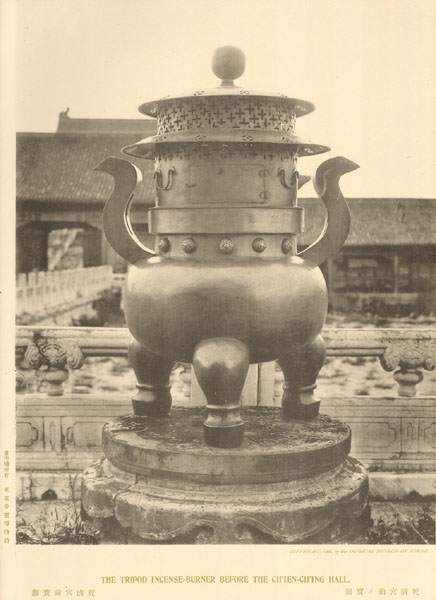 63. The Chia-liang before the Ch'ien-ch'ing Hall
63. The Chia-liang before the Ch'ien-ch'ing Hall
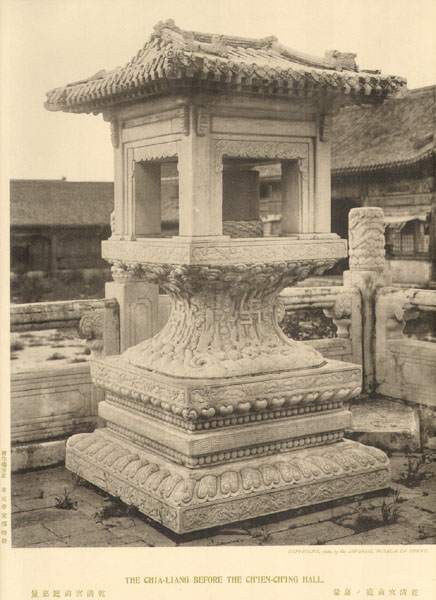 64. The Doors of the End Compartment of the
Ch'ien-ch'ing Hall: No. 1
64. The Doors of the End Compartment of the
Ch'ien-ch'ing Hall: No. 1
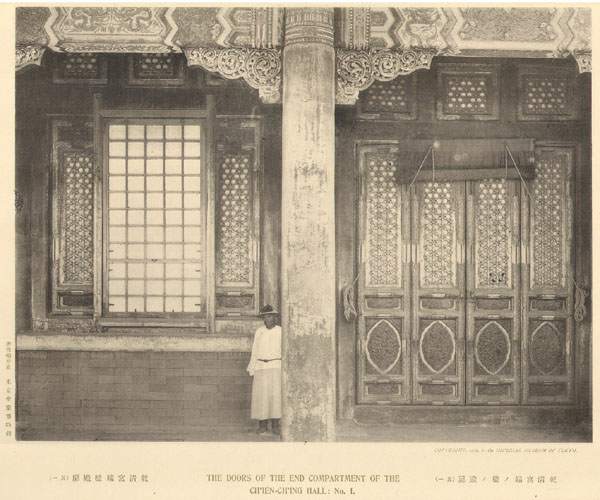 65. The Doors of the End Compartment of the
Ch'ien-ch'ing Hall: No. 2
65. The Doors of the End Compartment of the
Ch'ien-ch'ing Hall: No. 2
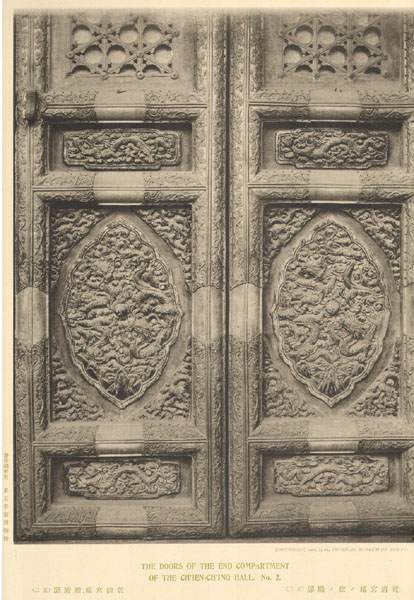
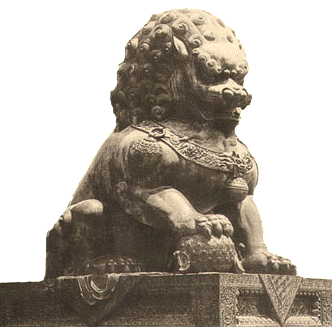
Listing of Plates (Vol 1 & 2, Nos. 1 to 172)
1. The T'ai-he Gate: No. 1
2. The T'ai-he Hall
3. The Ch'ien-ch'ing Hall
4. The City Wall North of Chao-yang Gate
5. The Chao-yang Gate
6. A Bird's Eye View of Tzu-ch'in Ch'eng
7. The Corner Tower (North-eastern)
8. Inside the Cheng-yang Gate
9. The T'ien-an Gate
10. The Hwa-piao in front of the T'ien-an Gate
11. The Hwa-piao in front of the T'ien-an Gate (Side)
12. The Wu Gate (Front)
13. The Wu Gate (Back)
14. The T'ai-he Gate; No. 2
15. The Chia-liang before the T'ai-he Gate
16. The Coffered Ceiling of the T'ai-he Gate.
17. The Front Steps of the T'ai-he Gate
18. The Ornamental Tops of the Newels around the
Platform of the T'ai-he Gate: No. 1
19. The Ornamental Tops of the Newels around the
Platform of the T'ai-he Gate: No. 2
20. The Chao-te Gate (Front)
21. The Chao-te Gate (Interior)
22. The Lion in front of the T'ai-he Hall
23. The Jih-kuei before the T'ai-he Hall
24. The Bronze Crane before T'ai-he Hall
25. The Bronze Turtle before T'ai-he Hall
26. The Front Steps of the T'ai-he Hall
27. The Central Flight of the T'ai-he Hall
28. The Platform of the T'ai-he Hall
29. A Back-Door of the T'ai-he Hall
30. The Front-Windows of the T'ai-he Hall
31. The Interior of the T'ai-he Hall
32. The Pillars and Coffers in the North-eastern
Corner of the T'ai-he Hall
33. The Ceiling Coffers behind the Dias in
the T'ai-he Hall
34. The Beams of the Western Corner of the T'ai-he Hall
35. The Imperial Dais in the T'ai-he Hall
36. The Imperial Dais in the T'ai-he Hall
37. The Central Beam and Coffers in the T'ai-he Hall
38. The Four Main Pillars in the T'ai-he Hall
39. The Coffered Vault above the Dais in the T'ai-he Hall
40. The Main Beam of the T'ai-he Hall
41. The Ceiling Coffers of the Cheng-he Hall
42. The Imperial Dais in the Cheng-he Hall
43. The Pao-he Hall (Front)
44. The Pao-he Hall (Back)
45. The Roof of the Pao-he Hall (Side)
46. The Imperial Dais in the Pao-he Hall (Side)
47. The Ceiling Coffers of the Pao-he Hall
48. The Central Back Flight of the Pao-he Hall
49. The Lower Part of the Central Back Flight of
the Pao-he Hall
50. The Flight of the Ch'ien-ch'ing Gate
51. The Flank Wall of the Ch'ien-ch'ing Gate
52. The Ceiling of the Ch'ien-ch'ing Gate
53. The Ceiling Coffers of the Ch'ien-ch'ing Gate
54. The Ch'ien-ch'ing Hall
55. Part of the Front of the Ch'ien-ch'ing Hall
56. Part of the Back of the Ch'ien-ch'ing Hall
57, Part of the Roofs of the Ch'ien-ch'ing Hall
58. The Railed Avenue of the Ch'ien-ch'ing Hall
59. The Central Front Flight of the
Ch'ien-ch'ing Hall: No. 1
60. The Central Front Flight of the
Ch'ien-ch'ing Hall: No. 2
61. The Side Front Flight of the Ch'ien-ch'ing Hall
62. The Tripod Incense-Burner before the Ch'ien-ch'ing Hall
63. The Chia-liang before the Ch'ien-ch'ing Hall
64. The Doors of the End Compartment of the
Ch'ien-ch'ing Hall: No. 1
65. The Doors of the End Compartment of the
Ch'ien-ch'ing Hall: No. 2
66. The Front Colonnade of the Ch'ien-ch'ing Hall
67. The Imperial Dais in the Ch'ien-ch'ing Hall
68. Part of the Imperial Dais in the Ch'ien-ch'ing Hall
69. The Treatment over the Door in the Ch'ien-ch'ing Hall
70. The Cabinet Doors in the Ch'ien-ch'ing Hall
71. The Mirror in the Ch'ien-ch'ing Hall
72. The Chiao-t'ai Hall (Side)
73. The Door of the Chiao-t'ai Hall
74. The Ceiling Coffers of the Chiao-t'ai Hall
75. The Imperial Dias in the Chiao-t'ai Hall
76. The Coffered Vault above the Dais in the
Chiao-t'ai Hall: No. 1
77. The Coffered Vault above the Dais in the
Chiao-t'ai Hall: No. 2
78. The Water Clock in the Chiao-t'ai Hall
79. The Kun-ning Kung (Front)
80. The Doors in the Kun-ning Kung
81. The Porch of the Yang-hsin Hall
82. The Imperial Dais in the Yang-hsin Hall
83. The Coffered Vault above the Dais in
the Yang-hsin Hall
84. An Inner Apartment of Yang-hsin Hall
85. The Bed Chamber in the Yang-hsin hall
86. The T'i-yuan Hall
87. The I-kun Kung (Interior)
88. The Yu-hwa Pavilion (Front)
89. The Chung-cheng Hall (Interior)
90. One of the Miniature Pagodas in the Hall of Buddha
91. A Specimen of the Miniature Stupas in the
Hall of Buddha
92. The Gable of Yung-kang Kung
93. The Roof of the Wu-ying Gate (Inside)
94. The Wen-yuang Pavilion (Front)
95. The Screen in the Yu-chien Pavilion
96. The Huang-chi Hall (Part of the Front)
97. The Huang-chi Hall (West Side)
98. The Ning-shou Kung
99. The Stair-case of the Ch'in-an Hall
100. The Base of the Ch'in-an Hall Platform
101. The Roof of the Ch'in-an Hall
102. The Ceiling of the Ch'in-an Hall
103. A Fountain
104. The Ch'ien-ch'iu Pavilion: (A)
105. The Ch'ien-ch'iu Pavilion: (B)
106. The Ritual Utensils in the Ch'ien-ch'iu Hall
107. The Chinag-hsueh Pavilion (Side)
108. The Yang-hsing Chai (Part)
109. The Shen-wu Gate
110. The Tsun-i Gate
111. The Fence Screen inside Tsun-i Gate
112. The Hsi-ch'ing Gate
113. The Ch'eng-kuang Gate
114. The Incense-Burner before the Yu-hwa Pavilion
115. Prospect Hill
116. A Pavilion in front of the Ta-kao-hsuan Hall
117. A View to the North from Prospect Hill
118. The Yung-an Temple Stupa and the Chi-tsui
Tui-yun Bridge
119. A Distant View of Yung-an Temple Stupa
from the North
120. A Near View of the Yung-an Temple Stupa
121. The Shrine in the South Front of the
Yung-an Temple Stupa
122. The Idol in the Shrine before the Yung-an Temple Stupa
123. The Chin-ao Yu-tung Bridge
124. The Gate leading to the Wan-fo Pavilion
125. The Wan-fo Pavilion (Front)
126. The Buddha's Hall, in the Shao-hsi-t'ien Ground
127. The Buddha's Hall (Part)
128. The Tzu-kuang Pavilion
129. The Hsiang-luan Pavilion in the Ying T'ai
Group: No. 1
130. The Hsiang-luan Pavilion: No. 2
131. The Hsiang-luan Pavilion and the Adjoining Jui-yang Pavilion
132. The Ch'un-ming Pavilion
133. A Summer House
134. The Fence Wall near the Ying T'ai Proper
135. The Marble Bridge of the Ying T'ai
136. The Pavilion in the "South Sea"
137. The Yun-hui Pavilion
138. The Shrine behind the Wan-shan Hall
139. The Seven-Storied Pagoda in the Shrine
140. The Gallery of the Wan-shou Shan Palace
141. The Pai-lou of the Wan-shou Shan Palace
142. The Wan-shou Shan Palace
143. The Pai-yun Hall and the Fo-hsiang Pavilion
144. The Fo-hsiang Pavilion (Back)
145. The Buddha's Hall (Chung-hsiang-chieh)
146. A Bird's Eye View of the Wan-shou Shan Palace
147. A Pagoda in the Rear of the Wan-shou Shan Palace
148. A stupa in the Rear of the Wan-shou Shan Palace
149. The Monument of K'un-ming Lake
150. The Ship-House on K'un-ming Lake
151. The Huang-ch'iung-yu or "Great Dome" in the
Temple of Heaven
152. The Interior of the Huang-ch'iung-yu
153. The Altar and the Gateways in the Temple of Heaven
154. The Ch'i-nien Hall in the Temple of Heaven
155. The Interior of the Ch'i-nien Hall
156. The Gate in the Temple of Agriculture
157. The Ch'ing-cheng Shrine in the Temple of Agriculture
158. The Base of the Platform of the Prayer hall in
in the Temple of Agriculture
159. The Hall of the Year Star in the Temple
of Agriculture (Part)
160. The Interior of Hall of the Year Star in the
Temple of Agriculture
161. The Interior of the Chu-fu Hall in the Temple of the Sun
162. The Interior of the Sermon Hall in the Yung-he Kung
163. The "Five Ritual Utensils" in the Sermon Hall of the
Yung-he Kung
165. The Interior of the Main Hall in the Eastern
Huang Szu: No. 1
166. The Interior of the Main Hall in the Eastern
Huang Szu: No. 2
167. The Pai-lou in the Western Huang Szu
168. The Western Huang Szu Stupa
169. The Gate of a Privea House: No. 1
170. The Gate of a Privea House: No. 2
171. The Shop Fronts: No. 1
172. The Shop Fronts: No. 2
|

